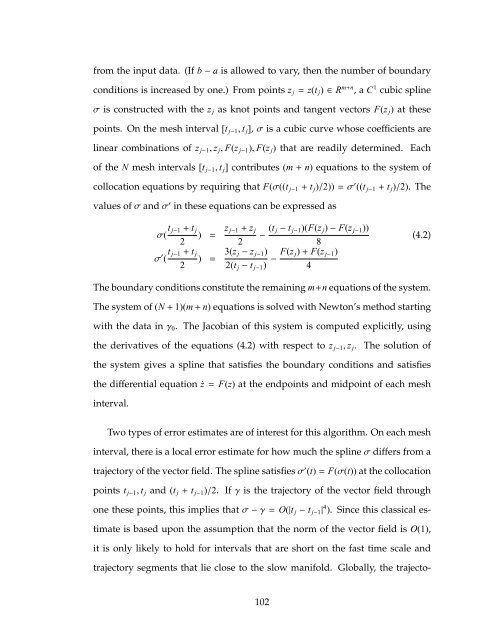multiple time scale dynamics with two fast variables and one slow ...
multiple time scale dynamics with two fast variables and one slow ...
multiple time scale dynamics with two fast variables and one slow ...
Create successful ePaper yourself
Turn your PDF publications into a flip-book with our unique Google optimized e-Paper software.
from the input data. (If b−a is allowed to vary, then the number of boundary<br />
conditions is increased by <strong>one</strong>.) From points z j= z(t j)∈R m+n , a C 1 cubic spline<br />
σ is constructed <strong>with</strong> the z j as knot points <strong>and</strong> tangent vectors F(z j) at these<br />
points. On the mesh interval [t j−1, t j],σis a cubic curve whose coefficients are<br />
linear combinations of z j−1, z j, F(z j−1), F(z j) that are readily determined. Each<br />
of the N mesh intervals [t j−1, t j] contributes (m+n) equations to the system of<br />
collocation equations by requiring that F(σ((t j−1+ t j)/2))=σ ′ ((t j−1+ t j)/2). The<br />
values ofσ<strong>and</strong>σ ′ in these equations can be expressed as<br />
σ( t j−1+ t j<br />
)<br />
2<br />
= z j−1+ z j<br />
−<br />
2<br />
(t j− t j−1)(F(z j)− F(z j−1))<br />
8<br />
σ ′ ( t j−1+ t j<br />
)<br />
2<br />
= 3(z j− z j−1)<br />
2(t j− t j−1) − F(z j)+ F(z j−1)<br />
4<br />
(4.2)<br />
The boundary conditions constitute the remaining m+n equations of the system.<br />
The system of (N+ 1)(m+n) equations is solved <strong>with</strong> Newton’s method starting<br />
<strong>with</strong> the data inγ0. The Jacobian of this system is computed explicitly, using<br />
the derivatives of the equations (4.2) <strong>with</strong> respect to z j−1, z j. The solution of<br />
the system gives a spline that satisfies the boundary conditions <strong>and</strong> satisfies<br />
the differential equation ˙z=F(z) at the endpoints <strong>and</strong> midpoint of each mesh<br />
interval.<br />
Two types of error estimates are of interest for this algorithm. On each mesh<br />
interval, there is a local error estimate for how much the splineσdiffers from a<br />
trajectory of the vector field. The spline satisfiesσ ′ (t)=F(σ(t)) at the collocation<br />
points t j−1, t j <strong>and</strong> (t j+ t j−1)/2. Ifγis the trajectory of the vector field through<br />
<strong>one</strong> these points, this implies thatσ−γ=O(|t j− t j−1| 4 ). Since this classical es-<br />
timate is based upon the assumption that the norm of the vector field is O(1),<br />
it is only likely to hold for intervals that are short on the <strong>fast</strong> <strong>time</strong> <strong>scale</strong> <strong>and</strong><br />
trajectory segments that lie close to the <strong>slow</strong> manifold. Globally, the trajecto-<br />
102
















